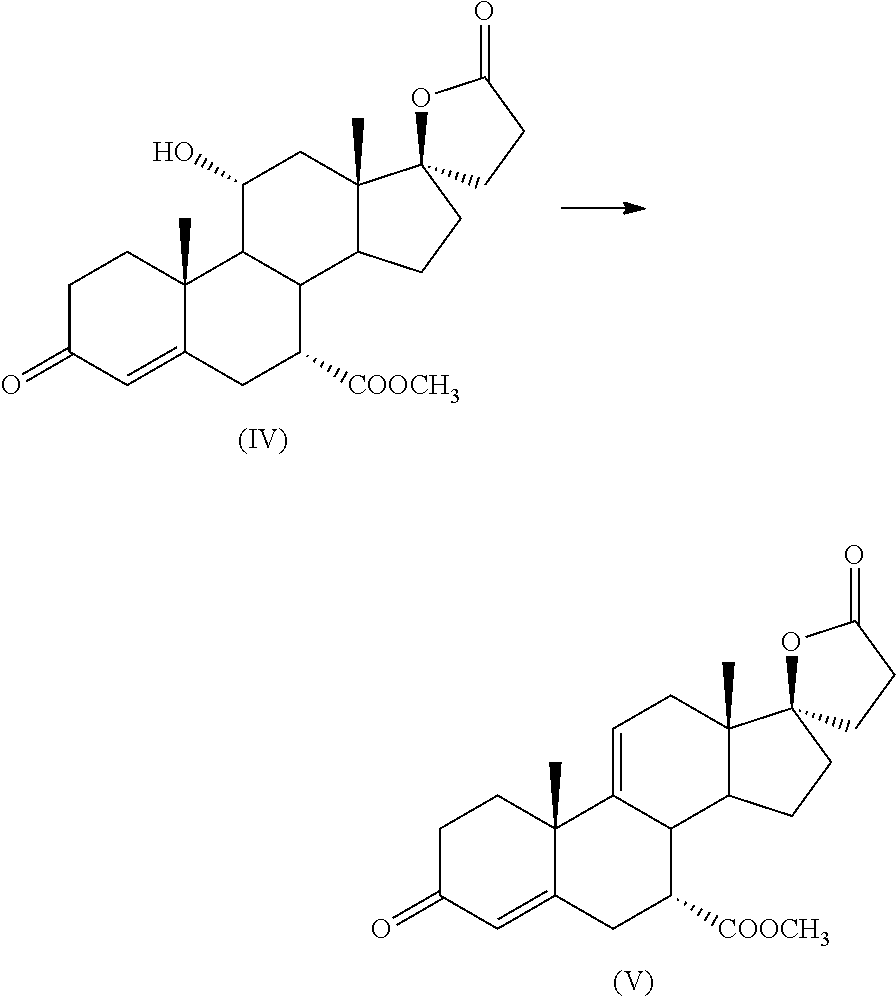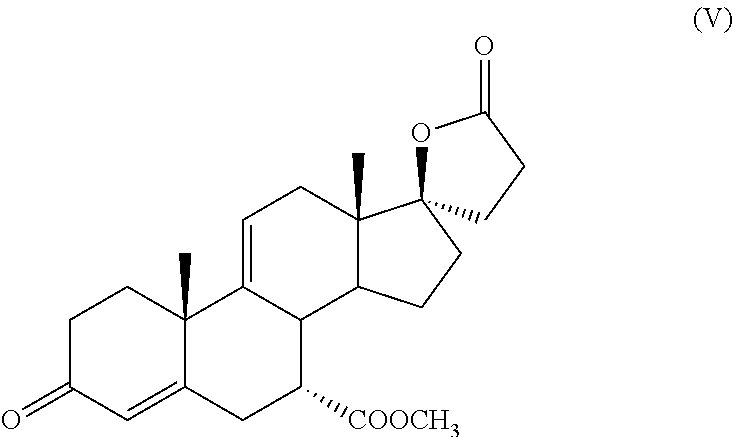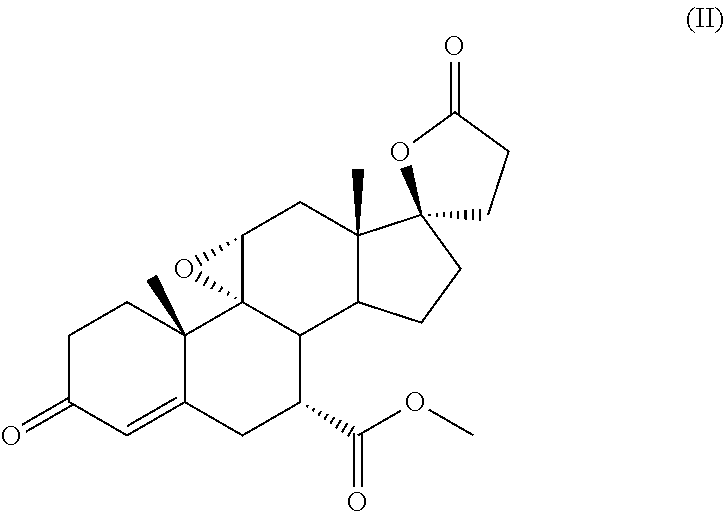PROCESS FOR THE PREPARATION OF 7 alpha -(METHOXYCARBONYL)-3-OXO-17alpha-PREGN-4,9(11)-DIEN-21,17-CARBOLACTONE, A USEFUL INTERMEDIATE FOR THE SYNTHESIS OF MOLECULES WITH PHARMACOLOGICAL ACTIVITY
a technology of methoxycarbonyl and oxo-17alpha, which is applied in the direction of steroids, organic chemistry, chemistry apparatus and processes, etc., can solve the problems of complex reactions, and achieve the effects of simple reaction, high yield and easy implementation on an industrial scal
- Summary
- Abstract
- Description
- Claims
- Application Information
AI Technical Summary
Benefits of technology
Problems solved by technology
Method used
Image
Examples
example 2
[0030]5 g of 11α-hydroxy-7α-(methoxycarbonyl)-3-oxo-17α-pregn-4-ene-21,17-carbolactone (IV) are suspended in 15 mL acetonitrile at room temperature; 2.55 ml Ishikawa reagent (Aldrich 564990) are added, thus obtaining a suspension.
[0031]The mixture is heated to 60° C. and after 2.5 hours, the progress of the reaction is checked by TLC: no reaction.
[0032]5 ml methylene chloride (capped reaction flask) are added, thus obtaining a clear solution after 30 minutes.
[0033]After 1 additional hour of reaction, the system is cooled to 25° C. checking the progress of the reaction by TLC: minimum formation of intermediate (V), starting intermediate (IV) largely prevalent.
[0034]It is left under stirring for 16 hours at 20-25° C. obtaining, after 16 hours, the disappearance of the starting intermediate (IV) with the formation of intermediate (V) plus other stains in the TLC.
[0035]The reaction is quenched by adding methanol first and then 15 ml of a basic aqueous solution of water-sodium bicarbonat...
example 3
[0040]10 g of 11α-hydroxy-7α-(methoxycarbonyl)-3-oxo-17α-pregn-4-ene-21,17-carbolactone (IV) are suspended in 100 mL chloroform at room temperature; 5.1 ml of reagent (VI) are added.
[0041]The mixture is stirred at 30° C., checking the progress of the reaction by TLC after 30 hours: reaction ended.
[0042]The reaction is quenched by adding methanol first and then 30 ml of a basic aqueous solution of water-sodium bicarbonate with pH=8 to the reaction mixture.
[0043]The phases are separated, the organic fraction is eliminated by distillation at reduced pressure, obtaining a yellow solid which is dried at T=45° C. at reduced P to constant weight (9.93 g); the solid is of suitable quality to be used for the next steps.
[0044]The content of intermediate (V), as determined by HPLC analysis, is equal to 8.63 g, corresponding to a yield of 90%.
example 4
[0045]This example is representative of the production of reaction mixture (VI).
[0046]At room temperature, 100 ml dichloromethane and 17.7 ml diethylamine are loaded in a flask.
[0047]It is cooled to T=−10° C. and, under stirring, 32.5 g hexafluoropropene are made to be absorbed by the solution over 10 hours.
[0048]The GC check shows the complete disappearance of diethylamine from the reaction mixture.
[0049]Dichloromethane is distilled at reduced pressure obtaining 33.7 g of reactive mixture (VI) which at the GC check shows the virtually exclusive presence of the two fluorinated components with 49.94 and 48.46% areas.
[0050]Such a mixture can be used as such without need for subsequent purifications.
PUM
| Property | Measurement | Unit |
|---|---|---|
| volume | aaaaa | aaaaa |
| volume | aaaaa | aaaaa |
| volume | aaaaa | aaaaa |
Abstract
Description
Claims
Application Information
 Login to View More
Login to View More - R&D
- Intellectual Property
- Life Sciences
- Materials
- Tech Scout
- Unparalleled Data Quality
- Higher Quality Content
- 60% Fewer Hallucinations
Browse by: Latest US Patents, China's latest patents, Technical Efficacy Thesaurus, Application Domain, Technology Topic, Popular Technical Reports.
© 2025 PatSnap. All rights reserved.Legal|Privacy policy|Modern Slavery Act Transparency Statement|Sitemap|About US| Contact US: help@patsnap.com



